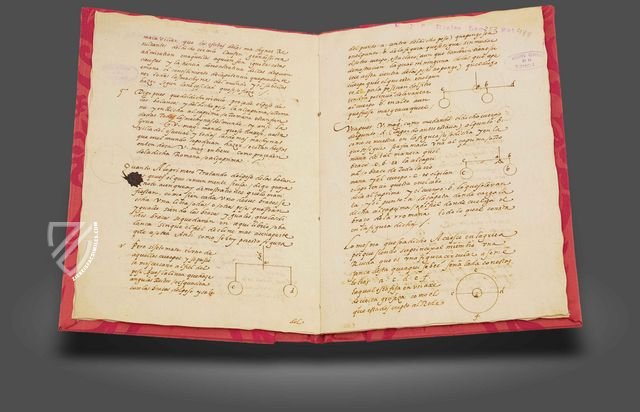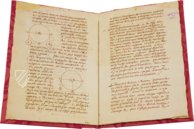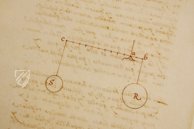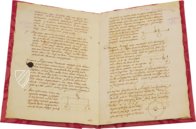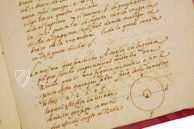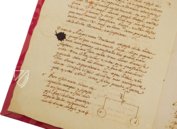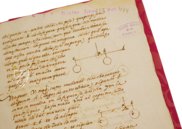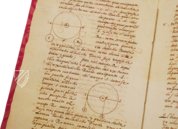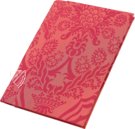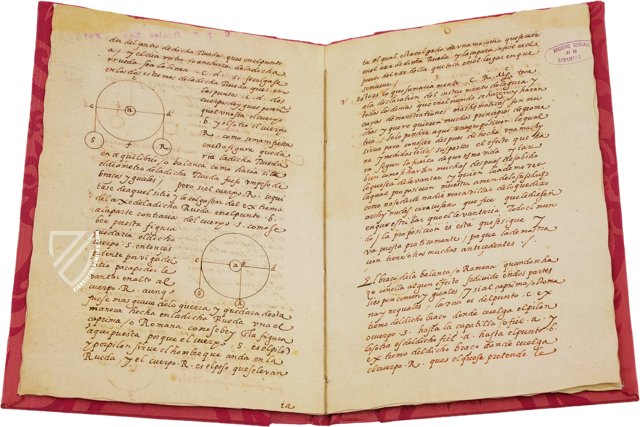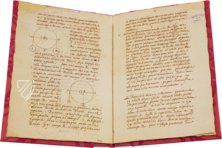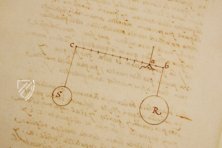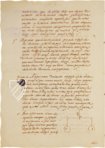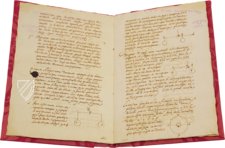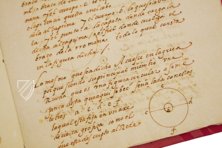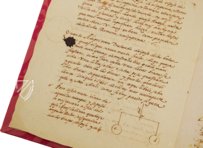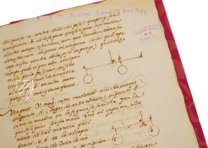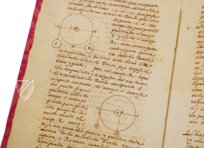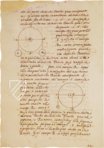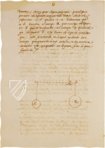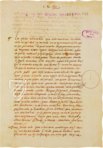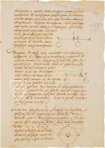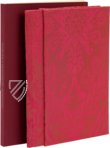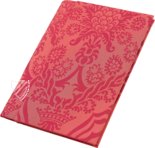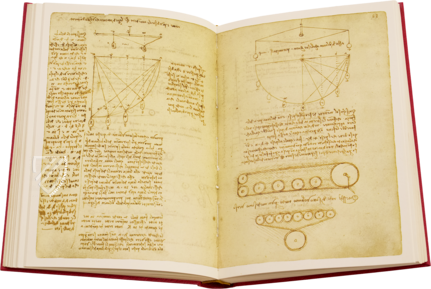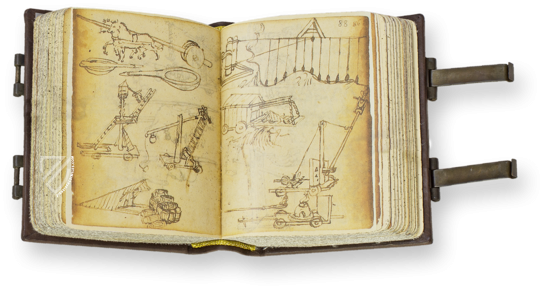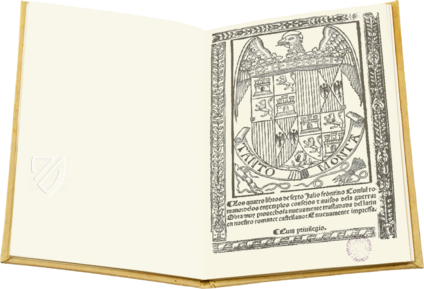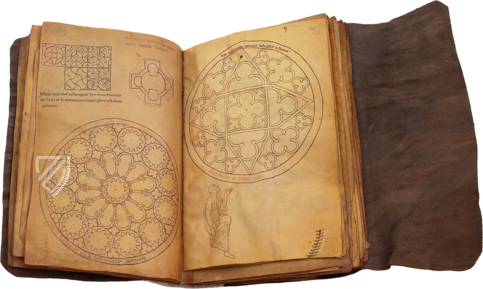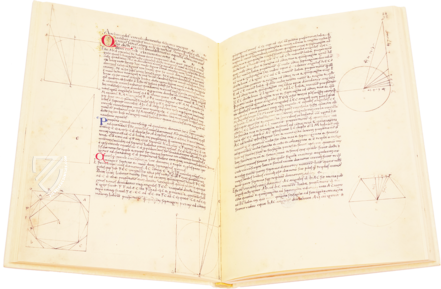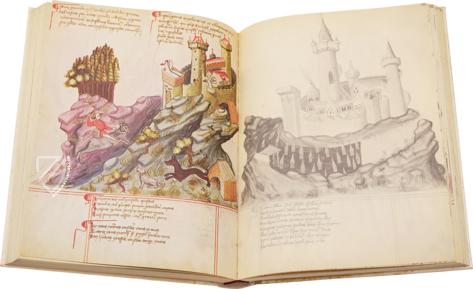Treatise of Architecture and Machinery of Juan de Herrera
(1,000€ - 3,000€)
King Philip II of Spain was a great patron of the arts and the most famous and impressive work associated with him is the royal palace and monastery of El Escorial, which is the largest Renaissance building in the world and was finished in 1584. Work on the giant complex was begun in 1563 under the direction of Juan Bautista de Toledo, but when he died four years later, the project was handed over to his apprentice, Juan de Herrera. In order to make this and other building projects more understandable for the King, the architect wrote a treatise in the tradition of the Roman author, architect, and civil and military engineer Vitruvius explaining various principals of structural and mechanical engineering, such as the use of pulleys. It was written sometime between 1567 and 1577 while construction on El Escorial was still ongoing.
Treatise of Architecture and Machinery of Juan de Herrera
The Spanish architect Juan de Herrera, royal architect and counselor to Philip II, is known not only for his famous construction project, the monastery and palace complex of El Escorial near Madrid, but was also active as a scientist and scholar in the fields of mathematics, philosophy, and others, in addition to composing more treatises. His Treatise of Architecture and Machinery is a special specimen, with whose help the famous architect was able to teach his king the operating principles of machines.
The Architect of the Spanish King
Beginning in 1563, King Philip II (1527–1598) commissioned the construction of Spain’s El Escorial, a royal monastery dedicated to Saint Lawrence. Today, the El Escorial palace and monastery counts among the most important sites in Spain and impresses with its gigantic size and austere reticence of the Renaissance architecture. Juan de Herrera (ca. 1530–1597) took over the building project in 1563 from Juan Bautista de Toledo, and directed the work until its completion in 1584, his visions lent El Escorial its distinctive appearance.
An Instructive Text
Juan de Herrera composed a treatise on architecture and machines in order to make the various building projects more understandable for the King, who supported the construction of the St. Lawrence Monastery with his heart’s blood. Probably originating between 1567 and 1577, alongside the theoretical part, it contains seven pages with drafts along with interesting scientific explanations. In this way, for example, the function of pulleys is demonstrated as they would have been employed in the construction of the royal monastery complex. The only signed drawing by the Spanish architect to survive can be found among them. Dedicated to the King, the treatise explains the complex mechanical processes related to architecture in a descriptive manner. With this formula, Juan de Herrera’s document stands in the tradition of Vitruvius, who also employed mechanics in his architectural teachings. Based on geography and natural philosophy, Herrera sought to make the fundamental principles of wondrous machines understandable. The treatise is a grandiose essay of both the architecture and – in the modern sense – engineering of the 16th century.
Architect and Scientific
Herrera’s treatise is stored today in the Archivo General in Simanca. The significance of the author not only as a royal architect, but also as a counsellor of the King in all scientific and technical matters, has not been lost today. Nonetheless, his role as a scholar and a scientist – he owned a large library with countless scientific essays – cannot be overestimated and the Treatise of Architecture and Machinery is considered to be an impressive example thereof.
Codicology
- Alternative Titles
- Tratado de Arquitectura y Máquinas de Juan de Herrera
Das Traktat der Architektur und der Maschinen von Juan de Herrera
Traité d’Architecture et de Machines de Juan de Herrera
Trattato di Architettura e Macchinari di Juan de Herrera
Tratado de Arquitectura e Máquinas de Juan de Herrera - Origin
- Spain
- Date
- Probably 1575
- Epochs
- Style
- Illustrations
- 7 diagrams
- Patron
- King Philip II of Spain (1527–98)
- Artist / School
- Juan De Herrera (ca. 1530–97)
Treatise of Architecture and Machinery of Juan de Herrera
Evidence of a Broken Pen
The author’s otherwise clear and elegant handwriting is marred by an ink blot, likely the result of a broken pen. Mistakes such as an ink blot remind us that manuscripts were not merely printed one day but were works in progress spanning months or years. While an incomplete miniature offers us insights into the process of their creation, all this ink blot tells us is that Juan de Herrera might have been in a rush that day and pressed the tip of his pen too hard into the parchment.
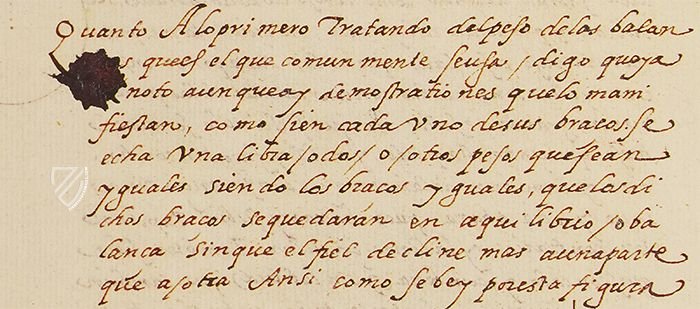
Treatise of Architecture and Machinery of Juan de Herrera
Torque
The concept of torque first emerged with the Greek polymath Archimedes of Syracuse, considered to be one of the greatest mathematicians of all time, when he was working with levers. Simply put, torque is the rotational equivalent of linear force, so rather than being a matter of push and pull, torque is the twisting force around a specific axis.
This page shows scenarios involving torque in which levers of unequal length are brought into balance with one another with the help of clearly drawn and labelled diagrams, which are incorporated into the text without being crowded by them. They show the relationship between the length of a lever and the position of its fulcrum, the same basic principle that governs the transmission of a car.
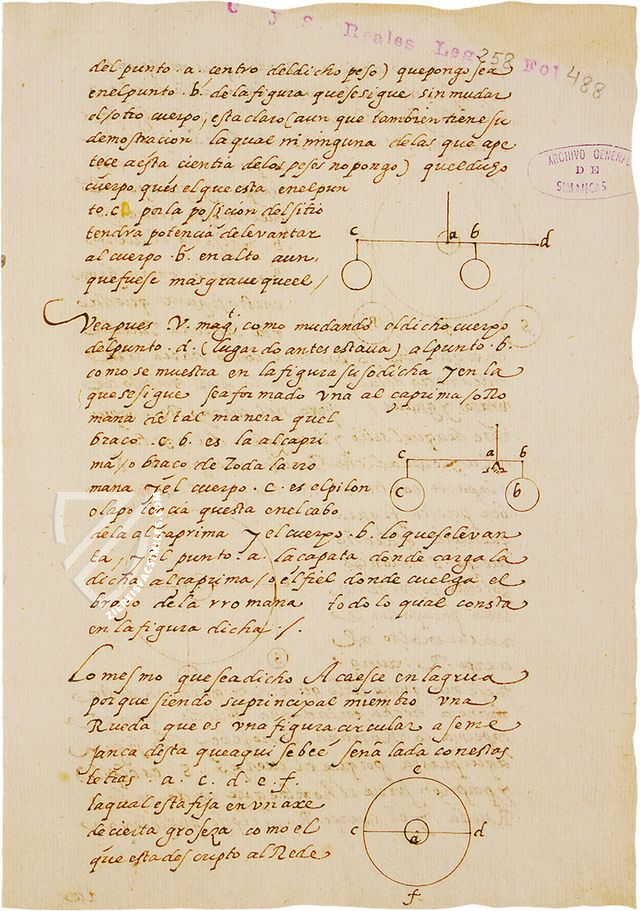
#1 Tratado de Arquitectura y Máquinas de Juan de Herrera
Language: Spanish
(1,000€ - 3,000€)
- Treatises / Secular Books
- Apocalypses / Beatus
- Astronomy / Astrology
- Bestiaries
- Bibles / Gospels
- Chronicles / History / Law
- Geography / Maps
- Saints' Lives
- Islam / Oriental
- Judaism / Hebrew
- Single Leaf Collections
- Leonardo da Vinci
- Literature / Poetry
- Liturgical Manuscripts
- Medicine / Botany / Alchemy
- Music
- Mythology / Prophecies
- Psalters
- Other Religious Books
- Games / Hunting
- Private Devotion Books
- Other Genres
- Afghanistan
- Armenia
- Austria
- Belgium
- Belize
- Bosnia and Herzegovina
- China
- Colombia
- Costa Rica
- Croatia
- Cyprus
- Czech Republic
- Denmark
- Egypt
- El Salvador
- Ethiopia
- France
- Germany
- Greece
- Guatemala
- Honduras
- Hungary
- India
- Iran
- Iraq
- Israel
- Italy
- Japan
- Jordan
- Kazakhstan
- Kyrgyzstan
- Lebanon
- Liechtenstein
- Luxembourg
- Mexico
- Morocco
- Netherlands
- Palestine
- Panama
- Peru
- Poland
- Portugal
- Romania
- Russia
- Serbia
- Spain
- Sri Lanka
- Sweden
- Switzerland
- Syria
- Tajikistan
- Turkey
- Turkmenistan
- Ukraine
- United Kingdom
- United States
- Uzbekistan
- Vatican City
- A. Oosthoek, van Holkema & Warendorf
- Aboca Museum
- Ajuntament de Valencia
- Akademie Verlag
- Akademische Druck- u. Verlagsanstalt (ADEVA)
- Aldo Ausilio Editore - Bottega d’Erasmo
- Alecto Historical Editions
- Alkuin Verlag
- Almqvist & Wiksell
- Amilcare Pizzi
- Andreas & Andreas Verlagsbuchhandlung
- Archa 90
- Archiv Verlag
- Archivi Edizioni
- Arnold Verlag
- ARS
- Ars Magna
- ArtCodex
- AyN Ediciones
- Azimuth Editions
- Badenia Verlag
- Bärenreiter-Verlag
- Belser Verlag
- Belser Verlag / WK Wertkontor
- Benziger Verlag
- Bernardinum Wydawnictwo
- BiblioGemma
- Biblioteca Apostolica Vaticana (Vaticanstadt, Vaticanstadt)
- Bibliotheca Palatina Faksimile Verlag
- Bibliotheca Rara
- Boydell & Brewer
- Bramante Edizioni
- Bredius Genootschap
- Brepols Publishers
- British Library
- C. Weckesser
- Caixa Catalunya
- Canesi
- CAPSA, Ars Scriptoria
- Caratzas Brothers, Publishers
- Carus Verlag
- Casamassima Libri
- Centrum Cartographie Verlag GmbH
- Chavane Verlag
- Christian Brandstätter Verlag
- Circulo Cientifico
- Club Bibliófilo Versol
- Club du Livre
- CM Editores
- Collegium Graphicum
- Collezione Apocrifa Da Vinci
- Comissão Nacional para as Comemorações dos Descobrimentos Portugueses
- Coron Verlag
- Corvina
- CTHS
- D. S. Brewer
- Damon
- De Agostini/UTET
- De Nederlandsche Boekhandel
- De Schutter
- Deuschle & Stemmle
- Deutscher Verlag für Kunstwissenschaft
- DIAMM
- Droz
- E. Schreiber Graphische Kunstanstalten
- Ediciones Boreal
- Ediciones Grial
- Ediclube
- Edições Inapa
- Edilan
- Editalia
- Edition Deuschle
- Edition Georg Popp
- Edition Leipzig
- Edition Libri Illustri
- Editiones Reales Sitios S. L.
- Éditions de l'Oiseau Lyre
- Editions Medicina Rara
- Editorial Casariego
- Editorial Mintzoa
- Editrice Antenore
- Editrice Velar
- Edizioni Edison
- Egeria, S.L.
- Eikon Editores
- Electa
- Emery Walker Limited
- Enciclopèdia Catalana
- Eos-Verlag
- Ephesus Publishing
- Ernst Battenberg
- Eugrammia Press
- Extraordinary Editions
- Fackelverlag
- Facsimila Art & Edition
- Facsimile Editions Ltd.
- Facsimilia Art & Edition Ebert KG
- Faksimile Verlag
- Feuermann Verlag
- Folger Shakespeare Library
- Franco Cosimo Panini Editore
- Friedrich Wittig Verlag
- Fundación Hullera Vasco-Leonesa
- G. Braziller
- Gabriele Mazzotta Editore
- Gebr. Mann Verlag
- Gesellschaft für graphische Industrie
- Getty Research Institute
- Giovanni Domenico de Rossi
- Giunti Editore
- Graffiti
- Grafica European Center of Fine Arts
- Guido Pressler
- Guillermo Blazquez
- Gustav Kiepenheuer
- H. N. Abrams
- Harrassowitz
- Harvard University Press
- Helikon
- Hendrickson Publishers
- Henning Oppermann
- Herder Verlag
- Hes & De Graaf Publishers
- Hoepli
- Holbein-Verlag
- Houghton Library
- Hugo Schmidt Verlag
- Idion Verlag
- Il Bulino, edizioni d'arte
- ILte
- Imago
- Insel Verlag
- Insel-Verlag Anton Kippenberger
- Instituto de Estudios Altoaragoneses
- Instituto Nacional de Antropología e Historia
- Introligatornia Budnik Jerzy
- Istituto dell'Enciclopedia Italiana - Treccani
- Istituto Ellenico di Studi Bizantini e Postbizantini
- Istituto Geografico De Agostini
- Istituto Poligrafico e Zecca dello Stato
- Italarte Art Establishments
- Jan Thorbecke Verlag
- Johnson Reprint Corporation
- Josef Stocker
- Josef Stocker-Schmid
- Jugoslavija
- Karl W. Hiersemann
- Kasper Straube
- Kaydeda Ediciones
- Kindler Verlag / Coron Verlag
- Kodansha International Ltd.
- Konrad Kölbl Verlag
- Kurt Wolff Verlag
- La Liberia dello Stato
- La Linea Editrice
- La Meta Editore
- Lambert Schneider
- Landeskreditbank Baden-Württemberg
- Leo S. Olschki
- Les Incunables
- Liber Artis
- Library of Congress
- Libreria Musicale Italiana
- Lichtdruck
- Lito Immagine Editore
- Lumen Artis
- Lund Humphries
- M. Moleiro Editor
- Maison des Sciences de l'homme et de la société de Poitiers
- Manuscriptum
- Martinus Nijhoff
- Maruzen-Yushodo Co. Ltd.
- MASA
- Massada Publishers
- McGraw-Hill
- Metropolitan Museum of Art
- Militos
- Millennium Liber
- Müller & Schindler
- Nahar - Stavit
- Nahar and Steimatzky
- National Library of Wales
- Neri Pozza
- Nova Charta
- Oceanum Verlag
- Odeon
- Orbis Mediaevalis
- Orbis Pictus
- Österreichische Staatsdruckerei
- Oxford University Press
- Pageant Books
- Parzellers Buchverlag
- Patrimonio Ediciones
- Pattloch Verlag
- PIAF
- Pieper Verlag
- Plon-Nourrit et cie
- Poligrafiche Bolis
- Presses Universitaires de Strasbourg
- Prestel Verlag
- Princeton University Press
- Prisma Verlag
- Priuli & Verlucca, editori
- Pro Sport Verlag
- Propyläen Verlag
- Pytheas Books
- Quaternio Verlag Luzern
- Reales Sitios
- Recht-Verlag
- Reichert Verlag
- Reichsdruckerei
- Reprint Verlag
- Riehn & Reusch
- Roberto Vattori Editore
- Rosenkilde and Bagger
- Roxburghe Club
- Salerno Editrice
- Saltellus Press
- Sandoz
- Sarajevo Svjetlost
- Schöck ArtPrint Kft.
- Schulsinger Brothers
- Scolar Press
- Scrinium
- Scripta Maneant
- Scriptorium
- Shazar
- Siloé, arte y bibliofilia
- SISMEL - Edizioni del Galluzzo
- Sociedad Mexicana de Antropología
- Société des Bibliophiles & Iconophiles de Belgique
- Soncin Publishing
- Sorli Ediciones
- Stainer and Bell
- Studer
- Styria Verlag
- Sumptibus Pragopress
- Szegedi Tudomànyegyetem
- Taberna Libraria
- Tarshish Books
- Taschen
- Tempus Libri
- Testimonio Compañía Editorial
- Thames and Hudson
- The Clear Vue Publishing Partnership Limited
- The Facsimile Codex
- The Folio Society
- The Marquess of Normanby
- The Richard III and Yorkist History Trust
- Tip.Le.Co
- TouchArt
- TREC Publishing House
- TRI Publishing Co.
- Trident Editore
- Tuliba Collection
- Typis Regiae Officinae Polygraphicae
- Union Verlag Berlin
- Universidad de Granada
- University of California Press
- University of Chicago Press
- Urs Graf
- Vallecchi
- Van Wijnen
- VCH, Acta Humaniora
- VDI Verlag
- VEB Deutscher Verlag für Musik
- Verlag Anton Pustet / Andreas Verlag
- Verlag Bibliophile Drucke Josef Stocker
- Verlag der Münchner Drucke
- Verlag für Regionalgeschichte
- Verlag Styria
- Vicent Garcia Editores
- W. Turnowski Ltd.
- W. Turnowsky
- Waanders Printers
- Wiener Mechitharisten-Congregation (Wien, Österreich)
- Wissenschaftliche Buchgesellschaft
- Wissenschaftliche Verlagsgesellschaft
- Wydawnictwo Dolnoslaskie
- Xuntanza Editorial
- Zakład Narodowy
- Zollikofer AG

